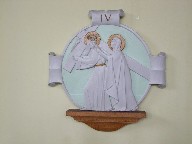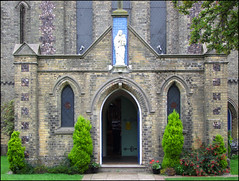| |
|
St Mary,
Southtown, Great Yarmouth
 |
|
Today,
Southtown is inextricably linked with Yarmouth.
It has long been part of the Borough, and the
warehouses off of Southtown Road face across to
Yarmouth's beautiful South Quay, with its elegant
town hall and grand Edwardian banks and public
houses; but by one of those quirks of England's
administrative history Southtown is historically
part of what was the Suffolk parish of Gorleston,
and was only moved into the county of Norfolk in
the 1920s. Before then, it is easy to
imagine the Yarmouth folk and the Southtowners
facing each other across the Yare with something
approaching suspicion. Southtown merges into the
urban area of Gorleston, and Southtown Road was
part of the London to Yarmouth road, known today
as the A12, which has only bypassed Southtown in
the last 20 years or so.
|
It is hard
today to imagine this place having a proud independent
life of its own, and perhaps it never did have, but it is
quite different in character to the southern part of
Great Yarmouth and Newtown across the water. A bridge has
long connected Southtown with the centre of Yarmouth, and
South Town station (the two-word station name an
idiosyncracy), on the line from Lowestoft and Beccles,
was closer to Great Yarmouth's town centre than either of
the two stations on the other side of the river. It
finally closed in 1970. Southtown's parish church,
however, is still alive, and continues to prosper. It
stands on Southtown Road, the former main road from
London, and must have been a familiar landmark to
thousands of holidaymakers, knowing that a sight of its
curious square spirelets meant that their journey was
almost at an end.
That the
style of this church is determinedly unecclesiological
has not endeared it to all visitors. Bill WIlson, writing
in the revised Pevsner, calls it depressing, but
this is surely unfair. St Mary is a Georgian church, a
great curiosity in Norfolk, built in 1831 to the designs
of Yarmouth's most prominent architect of the 19th
Century, JJ Scholes. That he would 'get' the approved
Gothic of the ecclesiologists later in the century is
clear from his fine St Mary's Catholic church in the
centre of Yarmouth, but his similarly idiosyncratic St
Peter (now St Spyridon) followed hot on the heels of St
Mary Southtown, and the two very different churches make
an interesting comparison.
Perhaps it
is the yellow brick of the exterior of which Wilson did
not approve. For myself, I rather like its gritty urban
feel, a reminder that Southtown is no mere characterless
suburb from the later decades of Queen Victoria's reign.
The building was extended with vestries in the last
decade of the century, and I suspect that the west porch
with its vivid statue and niche was also added at that
time.
You step
inside to an interior which, if anything, is even less
ecclesiologically-correct than the exterior, for there
are no arcades, no aisles, no chancel arch, just a large
square space with a smaller square chancel off of it, all
under ceilings. The east wall is blank, and the windows
to north and south have no coloured glass. It is robustly
pre-Victorian, and it is a shame that the west gallery,
which would have completed the piece, was removed in the
years before the First World War. Those who took it down
were no doubt following the precepts of the ritualist
movement, and they would be very pleased to discover that
their now-beleaguered movement is still in the ascendancy
at St Mary today, for this is a thorough-going
Anglo-catholic church. The grand reredos and panelling
came from Scholes's St Peter when that closed in the
1960s, as did the pulpit, which seems rather overlarge
here. The parish WWI memorial records a jaw-dropping 95
names, and I had to look twice to make sure that it was
not a roll of honour. But no, for these were the men who
left all that was dear to them, endured hardness, faced
danger and finally passed out of the sight of men by the
path of duty and self-sacrifice, giving up their own
lives so that others might live in freedom.
| In
the porch windows there are four simple roundels
to the evangelists, and by the the west doors is
a memorial to the man for whom they were
installed, a former organist. To the Glory of
the Great Architect of the Universe, it
begins, and lists his lodge memberships, a
reminder of how, in the early 20th century, the
Church of England and Freemasonry often went
hand-in-hand, so to speak. There is a delightful
font at the west end, as well-proportioned as any
Georgian birdbath, but thoroughly Gothick, with
faux-15th century panelling. You can't help
thinking that the young Scholes put a lot of
energy and enthusiasm into designing this place,
and it continues to be well looked after today. I came here
on the Historic Churches Bike Ride day of 2010,
and one of the welcomers was a jolly Maltese
lady, who told me that she came here rather than
to the Catholic church in the centre of Yarmouth
because it reminded her more of the churches at
home, although I suspect that the friendliness of
the other welcomers I met also had something to
do with it.
|
|
 |
|
|
|

